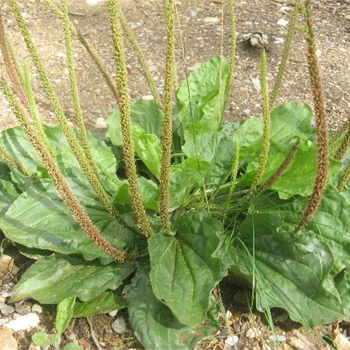Common Plantain, Broad-leaved Plantain, Lambstongue, Plantain Majeur • Legend and Lore • In the Garden |
|
| Plantago major
Plantaginaceae
Legend and Lore Plantago from the latin –foot sole; the leaves lie flat on the ground resembling a foot, major from the latin – greater or larger where another cultivar has narrow lanceolate leaves is the Plantago lanceolata. Canada’s First Nation named the plant “White foot” due to proliferation of plantain wherever the newcomers set foot. Each plant produces up to 14,000 seeds and establishing itself where there is a beaten path. Reputed to be used topically in poultices for treating snakebites, stings, and Poison ivy, plantain was for centuries medicinally used to treat oral and respiratory complaints. In Roman Times the plant was named plantago which signified “plant that acts,” a sacred plant for the Druids and worn as an amulet for prevention and as a cure all. Rich in vitamins A, C and K (important for blood clotting and bone mineralization) the flavor is like Swiss chard and spinach, young leaves can be eaten raw and older tougher leaves cut in chiffonade and cooked. Legend has it that a young woman was waiting for her lover at the edge of a walking path for such a long time that she was transformed into Plantain and now that same plant borders many a path! In the Garden Habitat is in cultivated land, pastures, meadows, wastelands, roadsides, lawns and gardens. Leaves are in a basal rosette, broadest in the middle, rounded to a pointed tip, margins are smooth or irregularly toothed, root system is thick and fibrous, and flowers are compact spikes on erect leafless stalks emerging from the basal leaves. |
|



